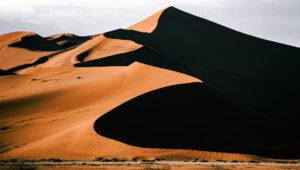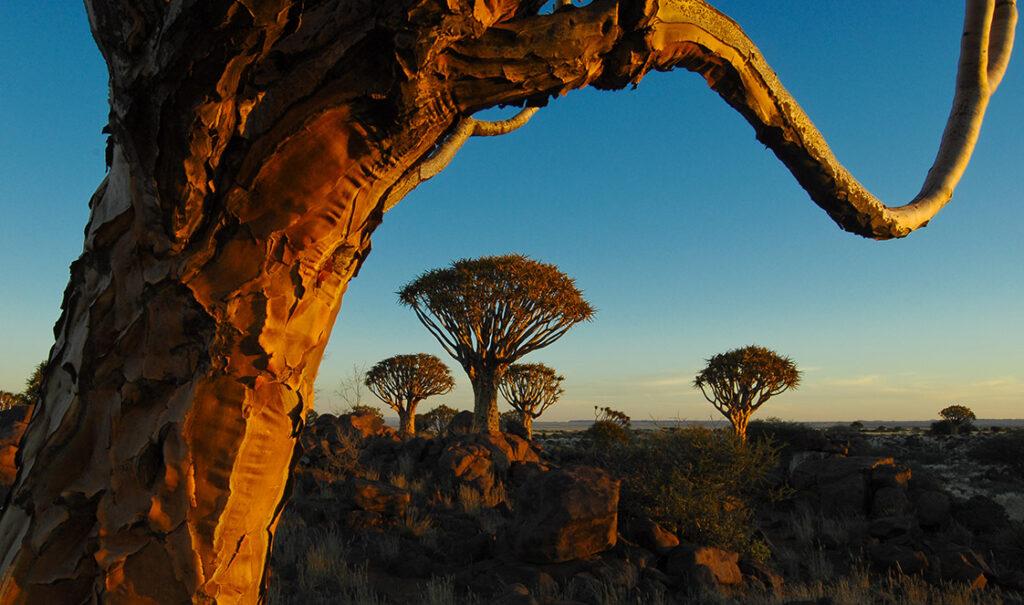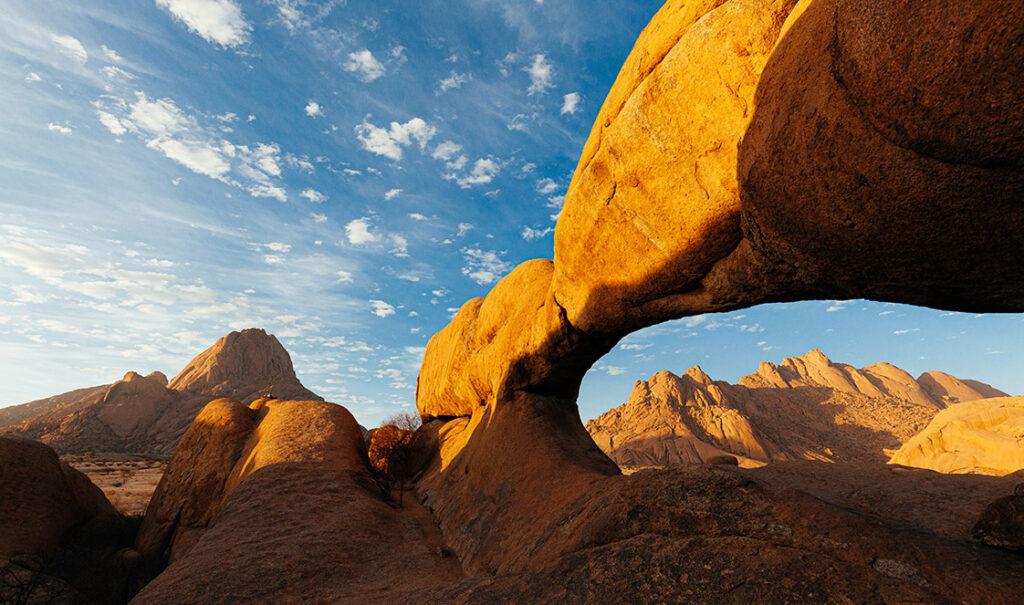Sossusvlei
49,768 sq. km (19,216 sq. mi) Namib-Naukluft National Park
1979 (Namib-Naukluft National Park)
All year
The oldest desert in the world
The Namib Desert is in one of the largest conservation areas in Africa (the Namib-Naukluft National Park) and it is here where you will find Sossusvlei, one of Namibia’s best-known and spectacular natural sites.

Sossusvlei: Home to the world’s tallest dunes
Towering rusty red sand dunes, bleached white clay pans with dead camel thorn trees, and mysterious fairy circles. These are some of the things which make the landscapes of Sossusvlei so spectacular and a must see for all travellers to Namibia.
Directly after entering the park, you will notice a road which leads approximately 4.5 km to the Sesriem Canyon. The canyon was shaped by the Tsauchab River over the course millions of years, and it was this river flowing through the canyon that once gave life to the now dried out pans of the Deadvlei and Sossusvlei. You can descend into the Sesriem canyon to take a walk along its usually dry riverbed and explore its interesting rock formations. It is only during times of heavy rain that the canyon holds water in some places.
Further down the road and deeper into the park, you enter a world of towering sand dunes, some of which are thought to be amongst the largest in the world. A particularly notable dune is the beautiful Dune 45. Named rather unimaginatively after its distance from the entrance gate (45 km), this 85 m high dune is one of the most popular dunes for travellers to climb as the view of the surrounding desert landscape presented form the top is awe-inspiring. Its remarkable shape and accessibility make it probably the most photographed dune in the world.
After a further 15 km the comfortable tarred road you are on ends and the 5 km 4×4 section taking you to the Deadvlei and Sossusvlei begins. There are parking facilities here so that visitors can park their vehicles and travel the last section by shuttle. Travellers who are more experienced when it comes to 4×4 driving can drive the upcoming off-road section themselves, provided they have the correct vehicle. Both the Deadvlei and Sossusvlei are clay pans which, hundreds of years ago, were supplied with water by the Tsauchab River. However, the climate changed, and the sand dunes encroached on the pans, blocking the river from reaching the area and causing the pans to dry out.
Although the Sossusvlei pan is more famous by name, it is the Deadvlei which is most commonly visited and photographed. Camel thorn trees grew here when there was water, but once the pan dried up these trees began to die. They still remain there, over 700 years later, their dark appearance in stark contrast to the cracked white pan. Their dead branches reach out as if they were calling for help. It creates a surreal atmosphere. Due to the lack of moisture in the region the trees do not decompose, instead they stand like statues, just as they have stood hundreds of years.
On your journey, you might also notice round baren patches of ground along the way. If you do, then you have probably discovered the mysterious fairy circles. What exactly causes these strange circles to appear has for many years been studied and hotly debated. As a result, various theories regarding their origin exist ranging from termites to different toxins in the ground. The most poetic explanation though, perhaps belongs to the local inhabitants of the region who call them the footprints of the gods. Whatever their cause, they add more mystery to this fascinating area.
The region surrounding Sossusvlei has a number of activities on offer for visitors to enjoy. You can take your pick and experience the desert’s beauty from all angles, from quad biking in the Sossusvlei dunes, to nature walks, to hot-air balloon flights, scenic microlight flights and so much more.
There are also plenty of different accommodations available in the area. These range from campsites to self-catering options, from basic lodges and tented camps to luxurious accommodations which will you make you never want to leave. The number of accommodations within the park’s boundary are however, limited to only a handful of lodges and a main campsite. The advantage of staying within the park’s border is that it allows you to enter main park one hour earlier than if you were overnighting outside the park, making this a particularly enticing option for photographers.
You can visit Sossusvlei as part of a self-drive tour or a guided tour. If you go on a self-drive tour, you have the option to book a guided day trip to the Sossusvlei region.
A visit of the Namib Desert and the Sossusvlei region specifically, is essential in understanding what makes Namibia such a unique and fantastic destination to come and see. The spectacular scenery created by the imposing and impressive landscapes of the greater Sossusvlei region, will have you feeling like you are on another planet and leave you fascinated and intrigued for a long time to come.
Big Daddy
You can gain ultimate bragging rights by hiking to the top of the enormous 325-meter-high dune called ‘Big Daddy’, before running down its slope straight into the Deadvlei.
There are actually three "vleis"
You can visit all three of the ‘vleis’ in the area: There is the name giver, Sossusvlei, the most commonly photographed Deadvlei and the lesser visited Hiddenvlei.
Discover the Fairy Circles
You can investigate the mysterious ‘fairy circles’ which appear across the arid landscape. It remains unclear what exactly causes these strange barren circles to form, making them one of the desert’s unsolved mysteries.
WHEN TO GO
Best time to go to Sossusvlei
Sossusvlei is spectacular throughout the year. No matter when you visit, the landscapes will leave you in awe. Temperatures are warm all year-round, although admittingly slightly warmer in summer and in true desert fashion, it is very dry. However, during the summer months, the odd rain shower can come down over the surrounding area and in very special years, it may even rain in the Sossusvlei region itself. During this time, you might be able to witness the very rare sight of the normally dry pans filled with water and patches of green grass on the dunes.
Dry season
May to NovemberDry conditions and warm temperatures
Almost Just Like Dry Season
December to AprilRare chance of rain and hot temperatures
Why to go
Experience the eery atmosphere of the Deadvlei
The atmosphere of the hauntingly beautiful Deadvlei is something which must be felt. The over 700-year-old dead camel thorn trees, reaching out of the cracked white pan, with imposing orange Sossusvlei dunes as a backdrop, all under a sapphire blue sky creates a surreal landscape. It is not only a fantastic photo motif but also a wonderful place to reflect on the nature of our ever-changing natural world.


We spoiled ourselves with a helicopter flight over Sossusvlei. Dunes as far as the eye can see – an experience we will never forget.Wiebke & Rico | Self-Drive Trip
Where to stay in Sossusvlei
Location
Sossusvlei is located in the Namib Desert, in the west of Namibia. You enter the Sesriem National Park (which forms a part of the Namib-Naukluft National Park) after which all attractions can be accessed from a road that takes you to Sossusvlei. Only the last 5 km of the 65 km drive to the vlei are not tarred. Shuttles can take you across to the last 5 km, should you not have a 4×4 vehicle.
- Sossusvlei
- Windhoek 350 km | 4-5 hours’ drive
- Etosha National Park (Okaukuejo) 800 km | 9-10 hours’ drive
- Swakopmund 360 km | 5 hours’ drive
- Kalahari (Bagatelle Kalahari Game Ranch) 400 km | 4-5 hours’ drive
- Fish River Canyon 650 km | 7-8 hours’ drive
- Damaraland (Twyfelfontein) 740 km | 9-10 hours’ drive



Experience Namibia with us
Speak to one of our local advisors
Let's start planning your trip!
We will get back to you within 2 working days.































